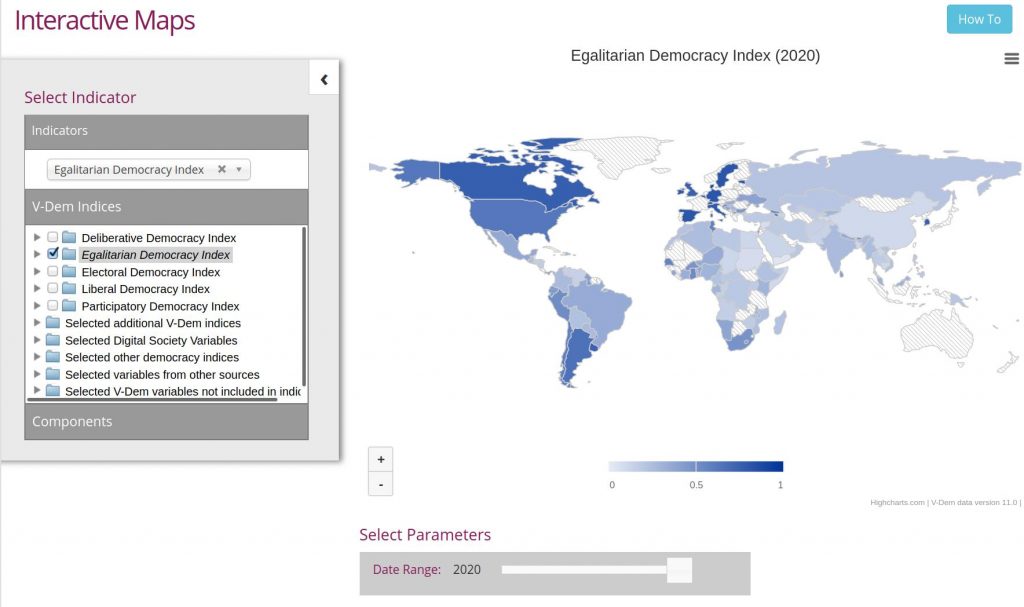UNIVERSELLE PROZESSPLANUNG
28.Aug 2021 – 6.Januar 2022
URL: oksimo.org
Email: info@oksimo.org
Autor: Gerd Doeben-Henisch (gerd@oksimo.org)
KONTEXT
Dieser Text ist Teil des Themenknotens DEMOKRATIE innerhalb des BEGRIFFLICHEN RAHMENS ZUM OKSIMO PARADIGMA innerhalb des oksimo.org Blogs.
Das V-dem Forschungsinstitut zur Demokratie
Das V-Dem Institut [1] ist ein unabhängiges Forschungsinstitut verortet in der Fakultät für Politische Wissenschaften der Universität von Göteborg (Schweden). Das Institut sammelt weltweit für jedes Land Daten zur Charakterisierung des Landes hinsichtlich seines Grades an Demokratie. Die Kriterien zur Charakterisierung sind sehr vielfältig. Neben einem jährlichen Bericht [2] kann man über interaktive grafische Webseiten auf diese Daten zugreifen.
BEISPIEL
Hier ein Beispiel zum Thema ‚Egalitarian Democracy‘ (‚egalitäre Demokratie‘):
Egalitarian Democracy [4]
By Milene Meneghetti Bruhn June 15, 2021 Weekly Graphs
This animation tracks the evolution of the egalitarian democracy index over the past 120 years. The index ranges from 0 (low) in blue to 1 (high) in yellow. Egalitarian democracy is founded on the principle that inequalities inhibit the full exercise of one’s formal rights and liberties and limit the political participation of citizens of varied social groups. Egalitarian democracy has three preconditions. First, the protection of rights and freedoms of individuals has to be equal across all social groups; second, resources must be distributed equally across all social groups; and third, groups and individuals must enjoy equal access to power. To measure egalitarian democracy, the index also considers the level of electoral democracy, which relies on political and civil freedoms, comprehensive and clean elections, and independent media.
The animated map shows that most countries lacked egalitarianism during the first half of the 20th century. Although Canada, Australia, and Sweden, for instance, were already slightly egalitarian during this period, most of the world’s countries were unequal. Large changes occurred at the end of World War II, when the countries of Western Europe, including Germany and France, as well as the US, pursued policies that achieved higher equality. In the subsequent years, Japan and the US also moved toward a more equal societal and economic distribution. Until the 1980s, the only nations with high levels of egalitarian democracy were those in the global north. But countries of the global south, such as Venezuela and India, scored higher on this index in the following decades. From the end of the millennium onward, multiple southern countries made movements towards more egalitarian democratic systems. Latin America largely re-democratized in the 1980s, after a period of authoritarianism, and much of Africa and Southeast Asia followed in the 1990s. In the past decade, however, multiple democracies have adopted less egalitarian models. These shifts seem to be a product of the rise of populist and rightist governments in populous countries such as the US, Brazil, and India. Not only do these governments show decreasing commitment to electoral democracy, but as the figure shows, these new leaders also violate egalitarian principles.
Interaktiver Graph

Mit einem Video von einer Konferenz [5]
Alternative Sicht
Eine alternative Sicht bietet statista, die sich als Quelle auf die Economist Intelligence Unit beziehen. Aus dieser Verschiedenheit kann man entnehmen, dass die Zuordnung von Kategorien im Detail sehr schwierig ist und zwangsläufig viele Ungenauigkeiten enthält. Dies resultiert einerseits aus der Komplexität des zu beschreibenden Gegenstandes und zum anderen aus der Begrenztheit der menschlichen Beobachter. Ein grundsätzlicher Trend ist aber offensichtlich: Abnahme von demokratischen Strukturen. Wichtig wäre hier, genau zu verstehen, warum dies so ist.
 Mehr Infografiken finden Sie bei Statista
Mehr Infografiken finden Sie bei Statista
